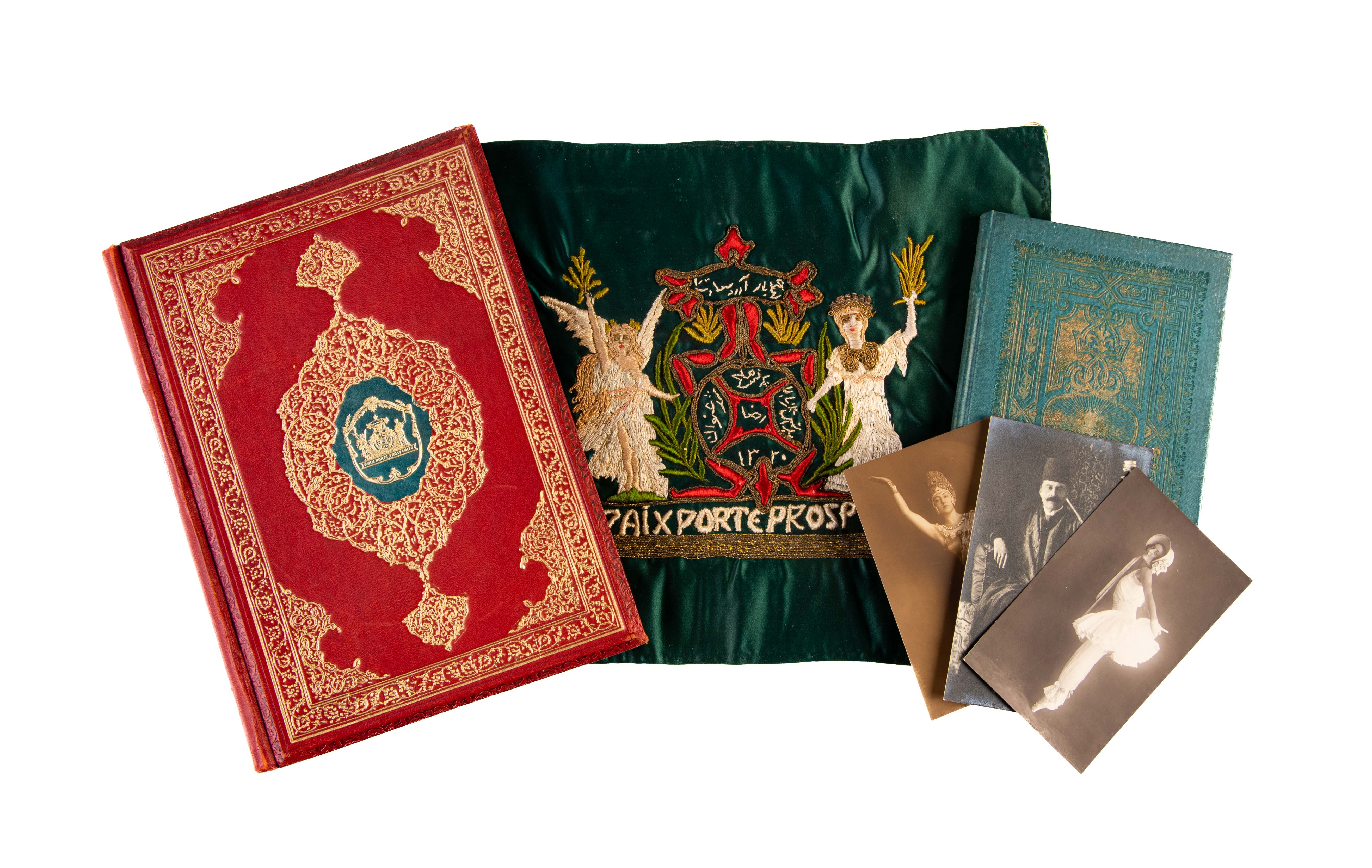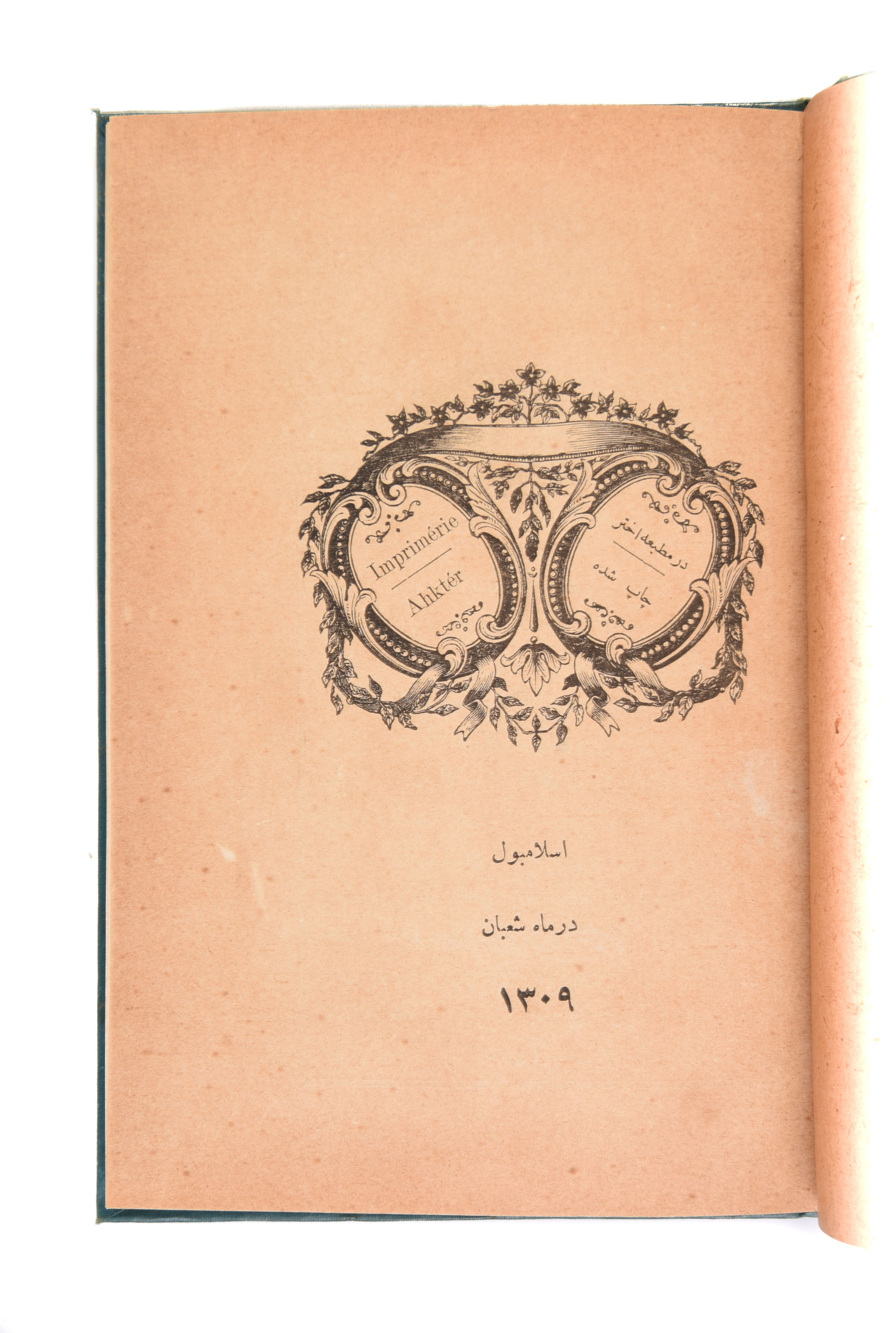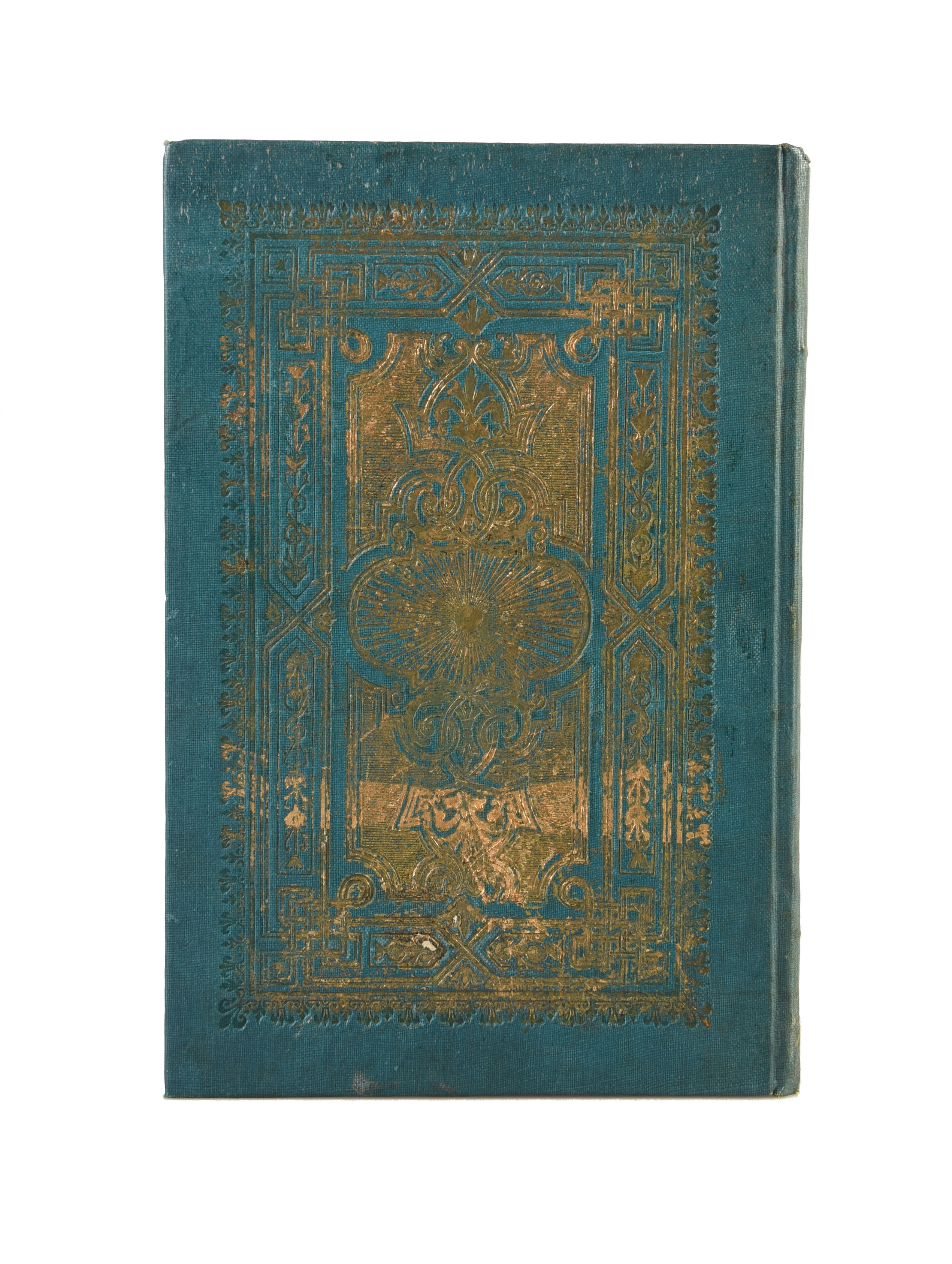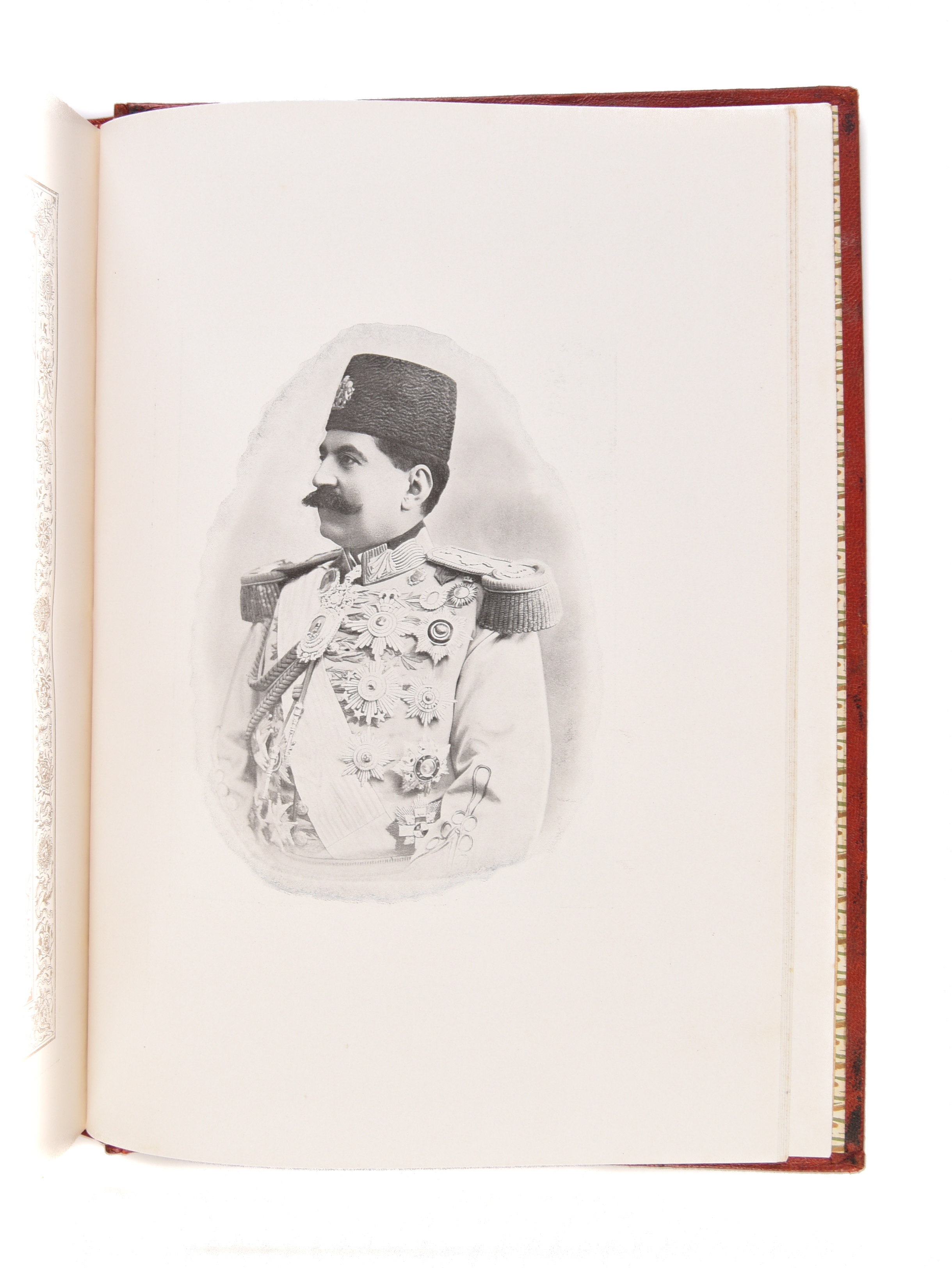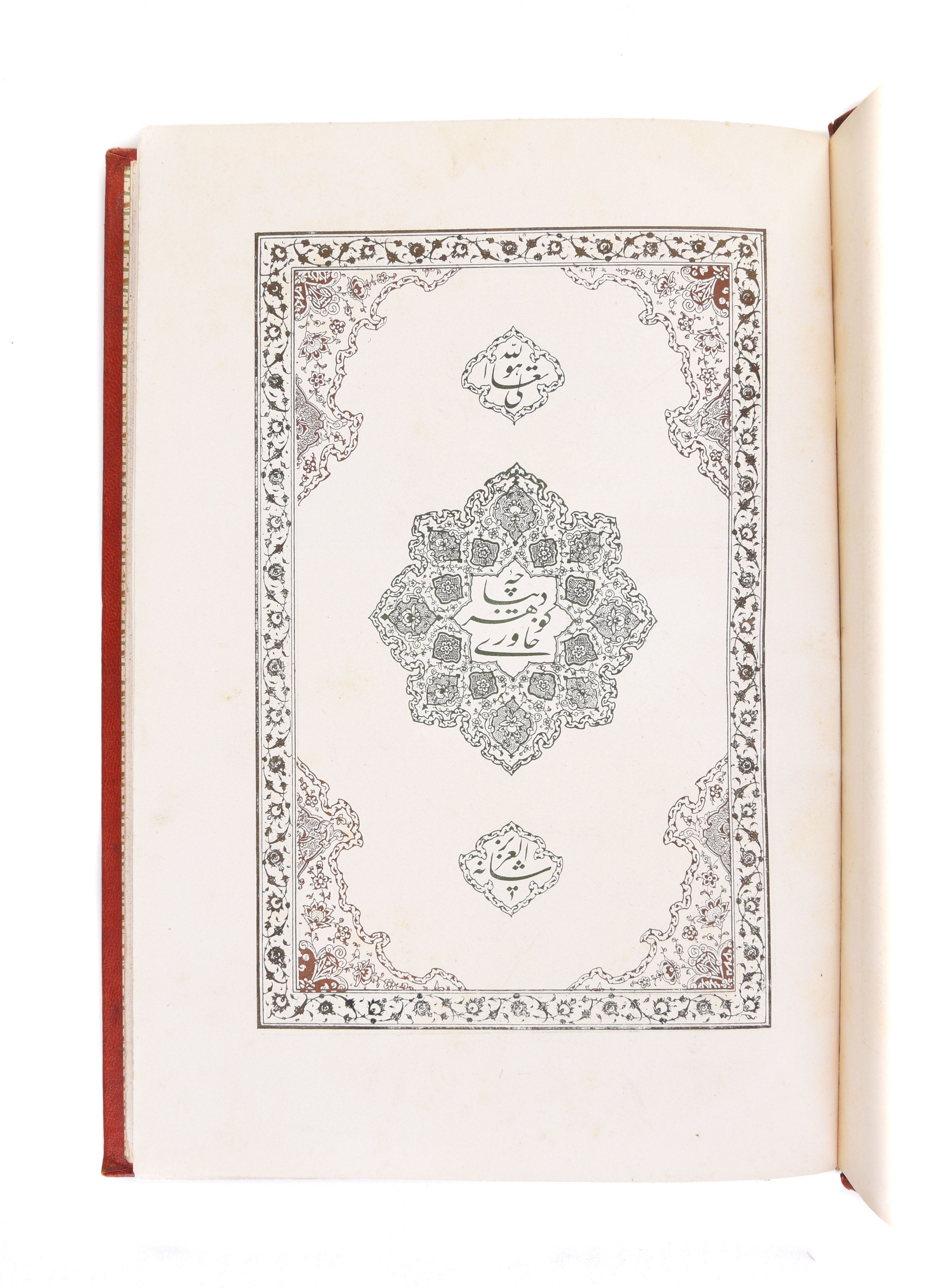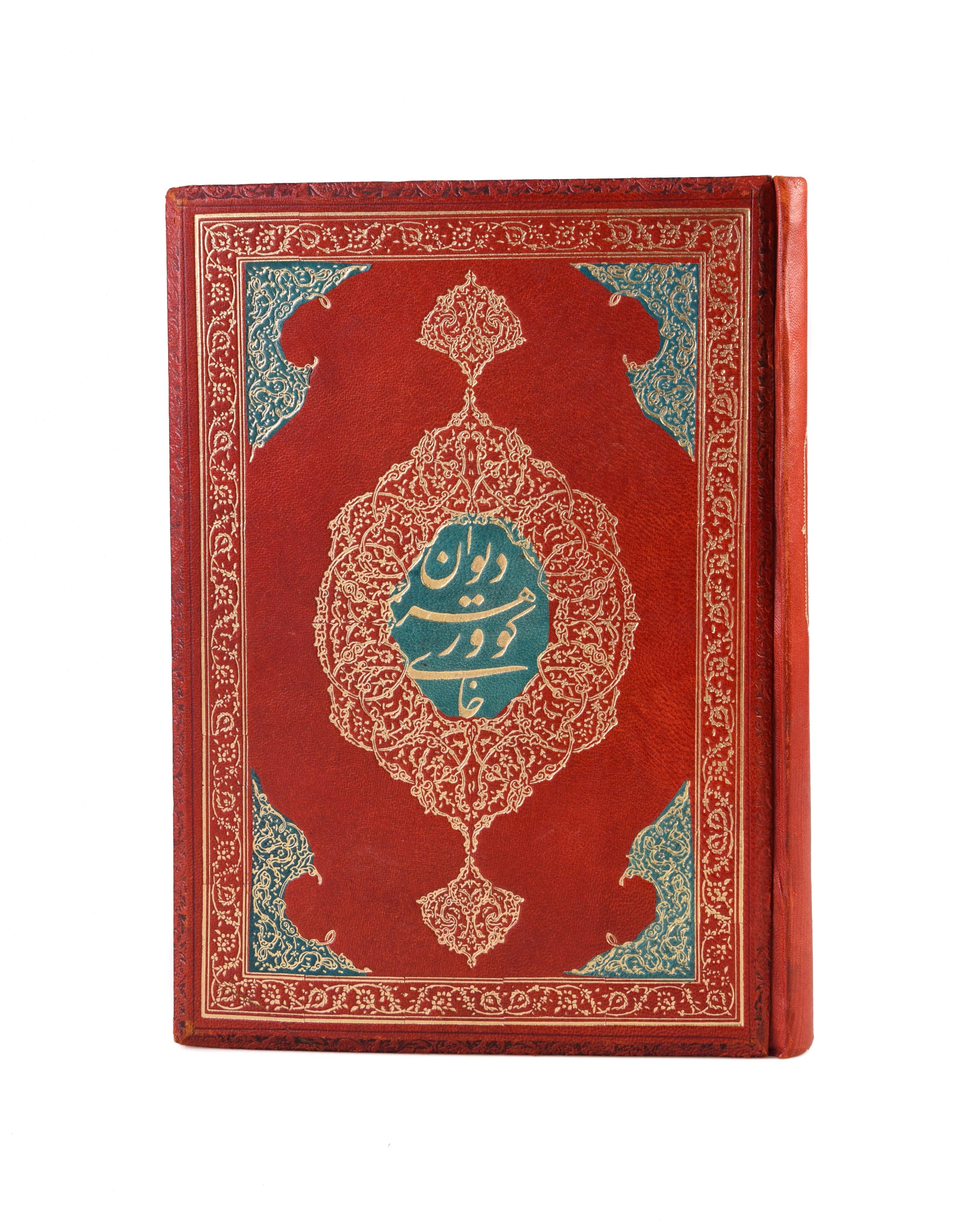Two books by Mirza Reza Khan, Persian diplomat and poet, with related material.
KHAN Mirza Reza (c.1920].)
£6000.00 [First Edition]
Please contact us in advance if you would like to view this book at our Curzon Street shop.
Life of a Qajar Diplomat
[1] ARFA’ (Riza), i.e. [KHAN (Mirza Reza)]. Muntakhab-i Danish. (Selected Knowledge). First edition. Varying lines of Persian naskh within double-ruled frames. Full-page black and white half-tone portrait of the author. 8vo. Original teal cloth, gilt, covers elaborately blind-stamped; spine a touch sunned, several tiny white stains to covers, otherwise very good. 96, 26pp. Istanbul, Matba’ahi-i Akhtar, 1309 AH [1892/93 AD].
[2] ARFA’ (Riza), i.e. [KHAN, (Mirza Reza)]. Divan Gohar Khavari. (Divan Eastern Gem). Presumed first edition. Lithographed Persian text, with varying lines of nasta'liq in chromolithographed gold floral borders, chromolithographed title-page printed in gold, iridescent red and iridescent green. With 72 full-page black and white photo-engravings (including 52 reproductions of ms. leaves, letters and certificates) and 9 full-page colour illustrations (a line-drawing repeated in different colours). 4to. Original orange-red morocco, richly gilt, green morocco central medallions to both covers, corner-pieces of green morocco inlay to upper cover, bevelled boards, speckled edges, lime green silk tie loosely inserted; extremities a little rubbed, a few light grazes to covers, otherwise very good. [1], 208, [5]pp. N.p., n.d., but [c.1905 AD].
[3] UNIDENTIFIED ARTIST. Needlework sampler of Mirza Reza Khan’s Coat of Arms. Sampler in white, green, red and gold thread on emerald fabric, measuring 270 by 320mm. Backed with linen, metal hoops at top corners, a little crumpled in places, a few threads coming loose, otherwise in excellent condition. N.p. [but likely Monaco], 1320 AH [1907/08 AD].
[4] UNIDENTIFIED PHOTOGRAPHER. Photograph of Mirza Reza Khan with a qalyan, and two photographs of his daughter Fatima in dance costumes. Three original silver-gelatin photographs, measuring 134 by 85mm, and 144 by 89mm. All in very good unfaded condition, one printed as a postcard with ms. message by Fatima in Swedish. N.p., n.d. but [Monaco,
A small but attractive gathering of items relating to the life of Mirza Reza Khan Arfa’ (1846-1939), a Persian diplomat who fulfilled a diverse array of roles during the late Qajar period. They exemplify the striking visual legacy he left behind in books, artworks and architecture, often mixing Western and Persianate features.
Reza was born in Tabriz and looked set for training at a religious school when a downturn in his family’s fortunes redirected his path to Istanbul, where his brother-in-law ran a shop. Outside of working hours he studied the manifold languages of the city, soaking up French and Turkish. It was in Tbilisi, on his return journey to Iran, that he took up a humble role at the Persian consulate and began to learn Russian. He was then in the right place at the right time when “the court of Naser al-Din Shah … needed a Russian interpreter for his journey across the Caucasus on the way to Europe” (Sirjani, Encyclopaedia Iranica), thus kick-starting his diplomatic career.
Having given a good account of himself, he was made third secretary at the Tiflis consulate and later won roles on the frontier commission of Khorasan-Ahal and the suite of the Shah for his final trip to Europe (cf. Diba, Tabriz in Monaco). After becoming consul-general in Tiflis, increasingly important roles followed, such as Minister to the Russian Court at St Petersburg (1312/1895), representative of Persia at the first Hague Conference (1899) and Ambassador to the Ottoman court (1317/1900).
Alongside his professional commitments he showed a strong appetite for the arts, not only as a collector but as the author of over a dozen books. Though his output is not of great literary significance — EI describes his poetry as “mediocre” (ibid.) — it stands as a fascinating example of cross-cultural book production at the turn of the century, with works in Farsi, French, Russian and Swedish, published across several cities, including Tehran, Istanbul, St. Petersburg, Paris and Stockholm. The two books here, Muntakhab-i Danish and Divan Gohar Khavari, are examples of his Persian-language poetry, the former printed with moveable type and the latter predominantly with lithography.
Divan Gohar Khavari, in particular, fully embodies his maximalist sensibility and desire to employ aspects of Persian book production. A work of biography in verse, it features typographic page numbers, lithographed text (in nasta’liq script) and chromo-lithographed borders and titles in gold and iridescent inks. All of which is printed on paper so smooth (presumably in imitation of polished paper), that the ink appears to have struggled to set. The illustrations, most of which are photo-engravings, show the author and various scenes from his career, including images of the Russian Court, Nicholas II and the empress consort, Alexandra Feodorovna.
The largest and most conspicuous of Reza’s creations were his houses, in Tabriz, Borjomi and Monaco, which took inspiration from the great masterpieces of Safavid architecture. Each contained large collections of Iranian art and items created by Reza’s family. The needlework sampler and small photographs give a sense of those interiors and though unsigned (apart from one photo-postcard) appear to have been made by his daughter Fatima at their Monaco residence (Villa Daneshgah), where the family lived for much of the time after 1910. The sampler copies Reza’s coat of arms, a beautiful design made in 1320 AH (1902/03 AD), with sewn titles and mottos in French and Farsi. One of the Farsi titles announces him as the ‘Prince of Peace’, and the French motto ‘Paix porte prospérité’ also points to the peacekeeping component of his diplomatic career; not to mention a nod to the wealth that came his way, some of which was gained “reportedly not always through honest means” (ibid.).
The photographs were probably taken at a studio in Monaco, or in Villa Daneshgah. Of small size, they were likely intended as gifts and keepsakes, with one used as a postcard by Fatima (written in Swedish, a language learnt from her Finnish mother, Elsa Lindberg-Dovlette). The two images of her, striking poses in differing dance attire, seem a small but fitting tribute to her father, proudly placing occident and orient side by side.
Both books are rare. Neither are recorded in LibraryHub, and OCLC locates just one copy of Muntakhab-i Danish, at the University of Utah. Divan Gohar Khavari appears to be unrecorded in Western library catalogues, but we have been able to trace a copy in Iran, at the Grand Ayatollah Boroujerdi Library in Qom.
References: ‘Ali-Akbar Sa’idi Sirjani, ‘Daneš’ in Encyclopaedia Iranica, 15 December 1993 (accessed 08 March 2022); Farhad Diba, ‘Tabriz in Monaco’ in The Iranian, 12 December 2003, (accessed 10 March 2022).
Stock Code: 243869
